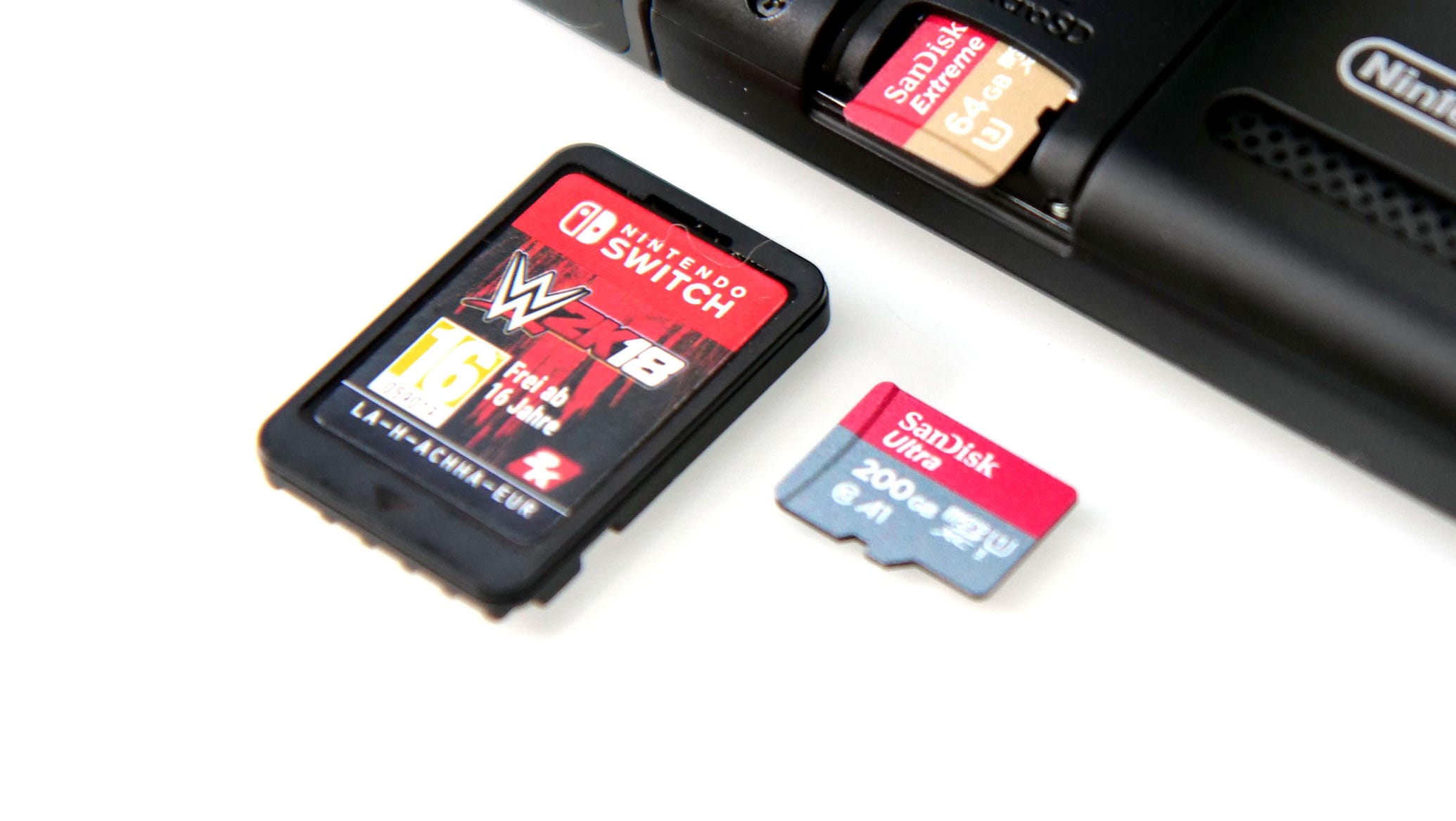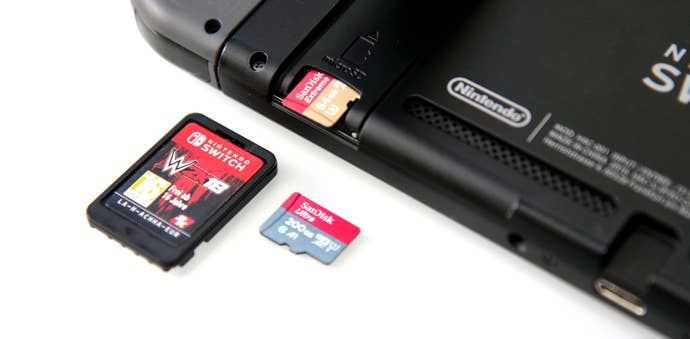The best MicroSD cards for Nintendo Switch 2025
The biggest storage upgrades at the best prices.

Grabbing one of the best MicroSD card slots for Nintendo Switch is a pretty much must-have purchase in 2025 as the dear old Switch's 25.9GB of accessible space isn't enough to keep multiple games, and to make matters worse, sometimes you can't fit larger AAA games onto it at all. To this end, the likes of the 512GB Kingston Canvas Select Plus is one of our favourites in the UK, while folks in the USA can benefit from the 512GB TeamGroup Pro Plus.
As well as simply recommending cards for you to try, we'll also share the results of our load time tests for different games, and also the best ways to move your data over from the internal storage to the SD card, and from the card to the internal storage, too.
Anyways, enough chat - here's our top picks for the best MicroSD cards for Nintendo Switch!

Best Switch MicroSD cards UK
For UK buyers, there's been something of a shift as 512GB cards now offer the best value per gigabyte by some margin, with 256GB and 1TB options close behind. 2TB cards are also getting much cheaper than before, meaning you don't pay much more per gigabyte to get a massive amount of game storage on your Switch.
| Buy from Amazon UK | Price | Value | |
|---|---|---|---|
| Best Overall Value Switch MicroSD Card | 512GB Amazon Basics | £30.99 | 6p/GB |
| Best Value 1TB Switch MicroSD Card | 1TB Samsung Evo Select | £69.99 | 7p/GB |
| Best Value 1.5TB Switch MicroSD Card | 1.5TB SanDisk Ultra | £104.99 | 7p/GB |
| Best Value 256GB Switch MicroSD Card | 256GB SanDisk Ultra | £20.39 | 8p/GB |
| Best Value 2TB Switch MicroSD Card | 2TB Lexar Blue | £181.49 | 9p/GB |
Best Switch MicroSD cards USA
Our US recommendations are slightly different, as there are more brands represented on Amazon.com than on its sister sites. We've selected four cards from a few different companies, all of which excellent value for money and come with favourable customer reviews. As of 2025, 512GB cards are the best options in terms of cost per gigabyte, with 256GB and 1TB cards nearly identical.
| Buy from Amazon US | Price | Value | |
|---|---|---|---|
| Best Overall Value Switch MicroSD Card | 512GB TeamGroup Pro Plus | $29.99 | 6¢/GB |
| Best Value 256GB Switch MicroSD Card | 256GB Silicon Power | $16.99 | 7¢/GB |
| Best Value 1TB Switch MicroSD Card | 1TB Amazon Basics | $67.50 | 7¢/GB |
| Best Value 1.5TB Switch MicroSD Card | 1.5TB PNY Pro Elite Prime | $109.99 | 7¢/GB |
| Best Value 2TB Switch MicroSD Card | 2TB SanDisk Extreme | $184.70 | 9¢/GB |
The Switch supported MicroSD cards up to 32GB at launch, but a software update soon thereafter pushed this limit all the way to 2TB. 2TB cards are now available, maxing out the MicroSD standard, and they're not even that much more expensive per gigabyte than the 1TB and 1.5TB cards that preceded them. The most important point here is that the more space you have, the more games you can install to the card and the less time you have to spend deleting or re-downloading games. Therefore, our recommendation is that you get the largest MicroSD card you can afford, though our recommendations also include best value offerings based on GDP or USD per gigabyte calculations.
Of course, capacity is only half of the equation - what about speed? Well, here the Switch isn't quite so future-proof. The console only supports UHS-1 cards, which have a maximum possible speed of 104MB/s, compared to the 312MB/s speed limit of the more modern UHS-2 standard. However, our testing revealed only a tiny differential between the slowest and fastest UHS-1 MicroSD cards on the Switch, so our recommendations are tailored towards capacity and value rather than speed.
As well as testing different MicroSD cards, we also examined two other options for playing Switch games: using internal storage and reading directly from the game cartridge. To get an accurate idea of which storage method is the fastest in different situations, we took frame-perfect load time recordings from The Legend of Zelda: Breath of the Wild. We tested both starting up the game and fast-travelling between areas, and the results were surprising - you'd think that Nintendo's own cartridges would offer the best loading times, but that's not the case...

| Zelda/Switch Load Times | Cartridge | Internal Storage | Sandisk 16GB Ultra SDHC | Sandisk 64GB Extreme SDXC |
|---|---|---|---|---|
| Temple of Time (Initial Load) | 35.7 | 30.7 | 34.1 | 34.4 |
| Kakariko Village (Initial Load) | 27.0 | 24.1 | 26.3 | 26.6 |
| Owa Daim Shrine (Initial Load) | 9.5 | 8.7 | 9.3 | 9.3 |
| Great Plateau Tower (Travel) | 32.6 | 27.7 | 30.9 | 31.2 |
| Dueling Peaks Tower (Travel) | 20.5 | 18.8 | 19.8 | 20.1 |
| Shrine of Resurrection (Travel) | 24.2 | 21.8 | 23.0 | 23.8 |
In every test, we got the same hierarchy of results: reading from the game cartridge was the slowest method, while the internal storage was the fastest. The two MicroSD cards we tested offered near-identical times, a little faster than the cartridge but slower than internal storage, sometimes by an appreciable margin. For example, in our Temple of Time load test, the internal storage was five seconds faster than the cartridge, and four seconds faster than either MicroSD card. That means if you want to absolutely minimise game load times, then installing your most-played games to the Switch's internal memory is a wise move.
Note: These tests were performed before Nintendo added a so-called 'boost mode' to Breath of the Wild, which pushes the Switch's processor to its limits to speed up the loading process when you first enter a game or move to a new area. However, the hierarchy of different storage methods remains the same.
Now that you have your selected MicroSD card installed, how do you move Switch games to MicroSD? Unfortunately, it's not currently possible to move game install data directly from the Switch's internal memory to a MicroSD card. Instead, you must follow a set of arcane instructions to archive the software, then download it again.
Start by visiting System Settings, selecting Data Management and then Manage Software. Then select the game you want to transfer, and select Archive Software, then Archive. Now, insert your MicroSD card, go back to the home screen and select the archived game. Select Download, and the game will be downloaded onto your MicroSD card. Your save data won't be affected (this is stored on the Switch's internal memory), but you will need to wait for the download to complete, which may be a pain for those with slower internet connections. If you want to move games to your internal storage, follow the same steps but remove the MicroSD card before downloading your game to ensure it is installed onto the Switch's flash memory.
To sum up, the fastest storage option is the 32GB of space that makes up the Switch's internal flash memory, so use this for your most-played games using the method outlined above if the absolute fastest loading speeds are your priority. MicroSD cards come next, offering comparable speeds and much larger capacities. When it comes to choosing the best MicroSD card, our advice would be firstly to choose a reputable brand (no-name cards are to be avoided, especially when good makes like Samsung, SanDisk and Kingston are reasonably priced). Secondly, as long as you're set with a UHS-1 card, you can afford to largely ignore read and write speeds and instead focus on choosing the largest capacity you can afford, as our testing didn't reveal a significant real-world advantage for higher-spec cards.

